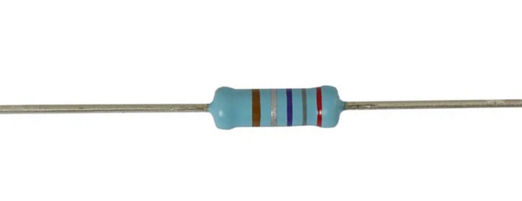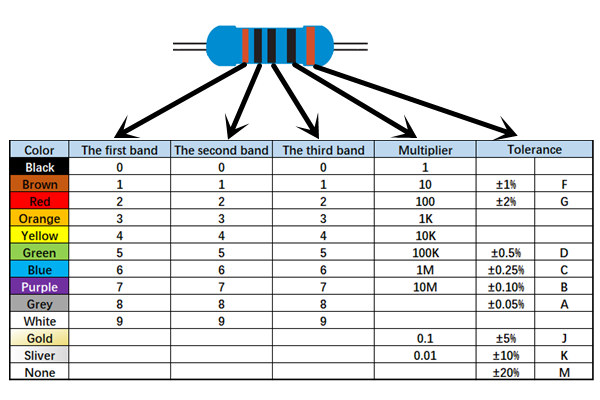A resistor with color bands enables users to determine the resistance value directly by reading the color bands, eliminating the need for additional measurements. Such color coding is predominantly found on cylindrical resistors like carbon film resistors, metal film resistors, metal oxide film resistors, fusible resistors, wirewound resistors, and others. These color bands are arranged in groups of four, five, or even six to signify the resistor's resistance value.

Color-coded resistors are among the most frequently used electronic components in circuitry. They feature differently colored bands painted onto the standard resistor casing to differentiate their resistance values. The fundamental units for these resistors include ohms (Ω), kilo-ohms (KΩ), and mega-ohms (MΩ). Specifically, 1 mega-ohm (MΩ) equals 1000 kilo-ohms (KΩ), or 1,000,000 ohms (Ω).
The common color-coded resistors are categorized into four-band and five-band types, with the former being more prevalent. In a four-band resistor, the first two bands denote digits, the third band signifies the multiplier, and the final band reflects the tolerance. In contrast, a five-band resistor uses the first three bands for digits, the fourth for the multiplier, and the last for the tolerance. Tolerance is usually represented by gold, silver, or brown hues. Gold stands for a 5% tolerance, silver for 10%, and brown for 1%. No color indicates a 20% tolerance, and occasionally green is used to denote a 0.5% tolerance.

Identifying Four-Band Resistors
A four-band resistor is defined by the use of four color bands to express its resistance value. Starting from the left, the first band represents the first significant digit, the second band the second significant digit, the third band the multiplier, and the final band the tolerance (or precision) of the resistor.
If distinguishing the first band proves challenging, the easiest method is to look at the "fourth band," which will either be gold or silver since other colors rarely appear there. This technique applies solely to four-band resistors and does not work for five-band ones.
Examples:
- Red, yellow, brown, gold: 24 x 10 = 240Ω, tolerance is 5%
- Green, red, yellow, silver: 52 x 10,000 = 520KΩ, tolerance is 10%
Identifying Five-Band Resistors
A five-band resistor uses five colored bands to represent its resistance value. From left to right, the first band denotes the first significant digit, the second the second significant digit, the third the third significant digit, the fourth the multiplier, and the fifth the tolerance range.
Example: Red, red, black, black, brown: 220 x 1 = 220Ω, tolerance is 1%.
Identifying Six-Band Resistors
A six-band resistor employs six colored bands to indicate its resistance value. The first five bands follow the interpretation method used in five-band resistors, whereas the sixth band represents the temperature coefficient of the resistor. These resistors are only utilized in specialized electronic devices and are relatively uncommon.
Automatic Cotton Quilt Quilting Sewing Machine
One Head Quilting Machine,Equipment For Making Microwave Gloves,Equipment For Making Apparel
Sichuan Kisae sewing machine Co.,Ltd. , https://www.kisaesew.com